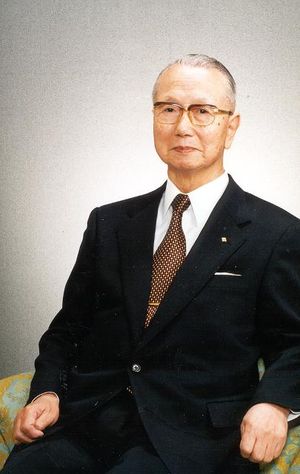Masasuke Morita
- Birthdate
- 1915/12/06
- Birthplace
- Utsunomiya, Japan
- Associated organizations
- NEC
- Fields of study
- Communications
- Awards
- IEEE Medal for Engineering Excellence
Biography
Masasuke Morita was born on December 6, 1915, in Utsunomiya, Japan. He obtained the B. Eng. and D. Eng. degrees, from the University of Tokyo in 1939 and 1951, respectively.
Dr. Morita joined Nippon Electric Corporation (NEC) in 1939. He retired as Executive Vice President for Information Processing in 1978, and remained as Senior Advisor until 1987. For over 20 years of his tenure at NEC, Dr. Morita played a central role in the development of microwave and satellite communication technologies. His work in wide-band communications encompassed the entire range of engineering from the basic ideas, to development of the circuitry, to incorporation into a complete system, to the production and operational use of such systems, and finally, publication of these contributions for the benefit of other engineers in the field.
Dr. Morita began his work in radio communications in 1945. He was responsible for many innovative and pioneering developments and their market applications, including: the microwave repeater system using a single travelling wave tube for both amplifier and oscillator; completely solid-state microwave repeaters; high sensitivity receiver systems; over-the-horizon communication systems; satellite communication earth station systems; and wide-band digital microwave communication systems. He was named General Manager of NEC's Radio Division in 1963, Senior Vice President in 1968, and Executive Vice President in charge of the Information Processing Group in 1974.
Of particular significance among Dr. Morita's contributions, was the invention and development of the high sensitivity receiving system in 1953, with Dr. S. Ito. This threshold extension system adopted the negative feedback' for FM (frequency modulation), avoiding the oscillation by inserting a narrow-band single tuned circuit in a wide-band IF (intermediate frequency) amplifier. It has been adopted almost universally in the satellite communication earth stations using FM. Continuing work in the field led to the adoption of negative feedback of PM (phase modulation) rather than FM. They then discovered that even with high speed modulation of several hundred voice channels, phase lock could be achieved, which led to the development of digital microwave communication systems.
In 1963, Dr. Morita proposed this system to NTT, which joined NEC in the development work. Thus, the world's first commercial microwave line by pulse code modulation-phase modulation (PCM-PM) was opened in 1968 by NTT in Kyushu,Japan. The first commercial digital microwave line was installed in the U.S. by New York Telephone between Brooklyn and Staten Island, using equipment supplied by NEC. Dr. Morita's most current work has been the development of a system for input of Japanese language text on computer.
Dr. Morita was a Life Fellow of IEEE and a Honorary Member of the Institute of Electronics, Informations and Communications Engineers (IEICE) of Japan. He has received many awards, including: The Medal with Purple Ribbon from the Prime Minister of Japan, the Imperial Invention Prize from the Japan Institute of Invention and Innovation, and the IEICE Special Prize for the best paper in 1989. He was the 1995 recipient of the IEEE Medal for Engineering Excellence.
Dr. Morita and his wife, Toyoko, resided in Yokohama. They had two sons. Dr. Morita played golf with a high handicap.
